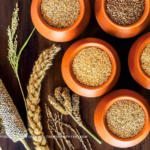You’ve been “on a diet” so long, you forgot what real food tastes like. Sound familiar? You’ve given up rice, sworn off ghee, labelled sweets as “evil,” and yet here you are — still struggling, still restricting, still feeling guilty every time you look at a samosa.
What if I told you that your grandmother, who ate rice daily, used ghee liberally, and enjoyed her occasional jalebi, probably had better metabolism than most people today? The problem isn’t your favourite foods — it’s the all-or-nothing mentality that’s keeping you trapped in the diet-binge cycle.
Here’s the truth nobody wants to tell you: You don’t need to starve or cut out rice, ghee, or sweets to stay fit. You need to understand how food actually works.
The Diet Industry’s Biggest Lie
“Cut carbs, lose weight fast!” “Eliminate sugar completely!” “Only eat between 12-8 PM!” Sound familiar? The diet industry thrives on making you believe that fat loss requires extreme sacrifice. But here’s what they don’t tell you:
95% of restrictive diets fail within 2 years.
Why? Because they’re based on deprivation, not education. They treat symptoms, not the root cause. They make you fear food instead of understanding it.
Meet Flexible Dieting: The Freedom Formula
Flexible dieting isn’t about eating whatever you want whenever you want. It’s about understanding that calories determine weight loss, not specific foods. It’s about working with your lifestyle, not against it.
The Core Principle:
- Calories In vs. Calories Out: This determines weight loss
- Food Quality: This determines health and satiety
- Sustainability: This determines long-term success
Think of it like a budget. You have X calories to “spend” each day. You can spend them on high-quality “investments” (nutritious foods) or occasional “treats” (your favorite indulgences) — as long as you don’t exceed your budget.
The 80/20 Rule: Your Sanity Saver
Here’s the magic formula that’s changed thousands of lives:
80% of your calories from nutritious, whole foods 20% from whatever makes you happy
In real numbers: If you eat 2000 calories daily, 1600 should come from quality foods (dal, rice, vegetables, protein, fruits), and 400 can come from your favorite treats (chai, biscuits, ice cream, sweets).
Cheat Meals vs. Planned Indulgences: The Smart Difference
The Problem with “Cheat Meals”
The word “cheat” implies you’re doing something wrong. It creates guilt, leads to overindulgence, and often triggers the “I’ve already ruined my diet” mentality that makes you give up entirely.
The Power of Planned Indulgences
Instead of random cheat meals, plan your indulgences:
Weekly Planning:
- Monday-Friday: Stick to your calorie budget with minimal treats
- Saturday: Enjoy a restaurant meal or family celebration
- Sunday: Have your favourite homemade dessert
Daily Planning:
- Budget 200-400 calories daily for treats
- Enjoy them guilt-free because they fit your plan
- No need for extreme restriction or extreme indulgence
Why Restrictive Diets Always Fail
The Psychological Trap
Restriction → Craving → Binge → Guilt → More Restriction
This cycle is exhausting and unsustainable. When you label foods as “good” or “bad,” you create an unhealthy relationship with eating.
The Physiological Reality
Extreme restriction leads to:
- Metabolic slowdown: Your body thinks it’s starving
- Muscle loss: Without adequate calories, you lose muscle, not just fat
- Hormonal imbalance: Affects hunger, mood, and energy
- Nutrient deficiencies: Restrictive diets often lack essential nutrients
The Flexible Dieting Roadmap
Step 1: Calculate Your Calorie Needs
Basic Formula:
- Men: Weight (kg) × 24 × activity level (1.3-1.7)
- Women: Weight (kg) × 22 × activity level (1.3-1.7)
For weight loss: Subtract 300-500 calories from your maintenance
Step 2: Set Your Macros (Optional)
Protein: 0.8-1.2g per kg body weight Fats: 0.5-0.8g per kg body weight Carbs: Fill the remaining calories
Step 3: Plan Your Day
80% Nutritious Foods:
- Whole grains (rice, oats, quinoa)
- Proteins (dal, chicken, eggs, paneer)
- Vegetables and fruits
- Healthy fats (ghee, nuts, oils)
20% Flexible Foods:
- Sweets and desserts
- Processed snacks
- Restaurant meals
- Beverages
Step 4: Track and Adjust
Use apps like MyFitnessPal or simply maintain a food diary. Track for 2-3 weeks to understand your patterns, then adjust as needed.
Making It Work with Indian Lifestyle
Festival Season Strategy
Diwali Week Example:
- Days 1-3: Stick to maintenance calories
- Day 4 (Main celebration): Enjoy freely, don’t count
- Days 5-7: Create a small deficit to balance out
Result: Enjoy festivals without gaining weight
Wedding Season Survival
The Smart Approach:
- Eat protein-rich breakfast before events
- Fill half your plate with salad at buffets
- Enjoy 1-2 favourite dishes mindfully
- Dance and stay active during celebrations
Office Party Navigation
The Flexible Strategy:
- Save calories during the day for evening treats
- Choose protein-rich snacks when possible
- Enjoy 1-2 favourite items guilt-free
- Stay hydrated between alcoholic drinks
Your Food Freedom Declaration
Flexible dieting isn’t about eating whatever you want — it’s about having the freedom to enjoy life while achieving your goals. It’s about understanding that a slice of cake won’t ruin your progress, but believing it will might ruin your relationship with food.
Your grandmother was right. Food is meant to be enjoyed, not feared. The key is education, not elimination. Balance, not perfection. Progress, not punishment.
Stop dieting. Start living. Your body — and your sanity — will thank you.
Remember: The best diet is the one you can follow for the rest of your life. Make it flexible, make it sustainable, and make it yours.
Ready to break free from diet prison? Start with one planned indulgence today and experience the freedom of flexible eating.





